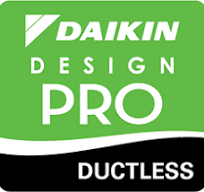Choosing the right heating and cooling system for your home can feel like a high-stakes decision. Cold winters, humid winters, and rising energy costs make investing in a system that offers comfort, energy efficiency, and long-term savings essential.
Homeowners often compare two popular options: traditional furnace/air conditioner systems and heat pump mini splits, which offer both heating and cooling. Each system has its strengths, and the best choice depends on your home’s layout and existing infrastructure.
What Is a Mini Split Heat Pump?
Most homeowners are familiar with a traditional heating and cooling setup that includes a furnace and an air conditioner, both connected to ductwork that circulates conditioned air throughout the home. These systems most often rely on both electricity and some form of fossil fuel (oil, propane, natural gas) to create the hot and cold air needed.
Heat pump mini splits are ductless or ducted heating and cooling systems that use electricity to move heat rather than generate it. In the winter, they pull heat from the outside air and bring it indoors. In the summer, the process reverses to cool your home. These systems consist of an outdoor compressor unit and one or more indoor air handling units. Thanks to advances in cold-climate heat pump technology, mini splits are now a reliable option even in frigid temperatures.
Pros and Cons: Furnace and AC vs. Mini Splits
Traditional Ducted Furnace & AC
Pros:
- Fast, strong heat output
- Often less expensive to install when replacing an old unit
Cons:
- Requires two separate appliances (furnace for heat and AC for cooling)
- Requires fuel, which can fluctuate in price
- Older ductwork can be inefficient and leaky if not properly sealed
Heat Pump Mini Splits
Pros:
- Provides both heating and cooling
- Energy-efficient, especially in homes without ducts
- Zoning capabilities let you control temperatures room by room
- Great for additions, finished attics, or any room not served well by ducts
Cons:
- May require multiple indoor units
- Aesthetic considerations with wall or ceiling-mounted units
When Are Mini Splits the Better Option?
Mini split heat pumps shine in homes without ductwork or in areas where ducts don’t reach— think finished basements, sunrooms, attics, or additions. They’re also ideal for older homes where installing new ductwork would be expensive or disruptive.
For homeowners looking to add air conditioning or improve comfort in specific zones without touching the whole house, mini splits offer a smart, flexible solution. And in New York’s cold climate, today’s cold-climate heat pumps are more than capable of keeping your home warm year-round.
When Does a Furnace Make More Sense?
If your home already has ductwork that’s in good shape, a traditional furnace may be the most straightforward solution. Upgrading to a high-efficiency furnace can improve your comfort and reduce fuel consumption without the need to reconfigure your home’s layout.
You Can Also Combine Systems
There’s no rule saying you have to choose one or the other. In fact, many NY homeowners are opting for hybrid solutions. For example, a mini split can be added to your existing central heating and cooling system to provide zoned comfort to an area that your ductwork doesn’t reach. Rather than replace your old system, supplement it with a heat pump to get efficient comfort in all seasons.
Energy Efficiency and Incentives
Whether you’re leaning toward a mini split system or a new furnace, it’s important to consider long-term efficiency. Heat pumps generally have lower operating costs than fossil fuel systems, especially when paired with a well-insulated and air-sealed home.
And thanks to NYSERDA rebates and federal tax incentives, making the switch to heat pumps has never been more affordable. Energy Savers can help guide you through available programs and maximize your savings.
At Energy Savers, We Find What’s Right for Your Home
Every home is different. At Energy Savers, we take a building science approach to every HVAC upgrade. That means assessing your home’s insulation, air sealing, layout, and lifestyle needs before recommending a solution. We won’t push one system over another—we’ll help you make an informed choice that makes sense for your home and your budget.







